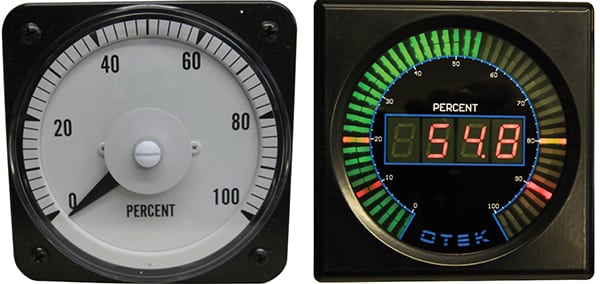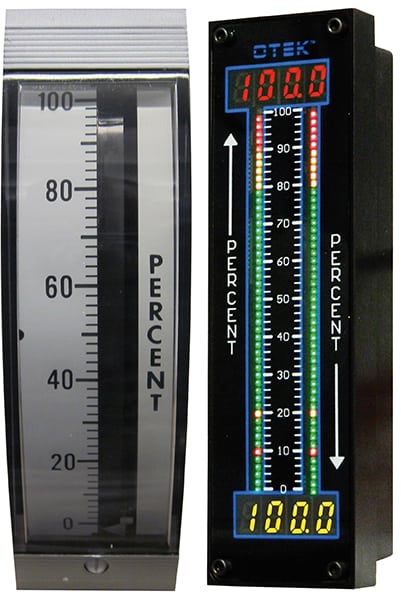New Digital Meters Replace Old Analog Meters
Power plants use indicators to monitor process parameters such as pressure, flow, temperature, voltage, current, and vibration. Unless a facility is relatively new, it likely has analog panel meters; some plants have hundreds of them.
One reason companies resist upgrading to digital meters is that digital meters have historically required an external source of power to control the electronics. Many analog meters operate off the instrument loop power and don’t have external power supplies.
Advantages of Digital Meters
As instrumentation and control technology has improved, many control room meters have become outdated. For years, many have questioned what would be the best replacement meter for their control room panels. Is it an analog meter, which provides less accuracy, yet has no rewiring cost? Or is it a digital meter, which offers higher accuracy but has a high rewiring cost?
Digital meters are better than analog in many ways. They don’t suffer from parallax like analog meters, so they can be read from a greater distance. The needle never gets stuck, and they are generally more accurate. They are also less susceptible to shock and vibration problems, and they don’t drift out of calibration.
Digital bar graph meters offer another advantage. In addition to the illuminated numerical display, the bar graphs can be programmed for intuitive green LED indication when the process is within its normal operating range, and with yellow or red when off normal or in alarm. This feature allows operators to quickly identify problems in their process parameters.
New Technology Meters Offer a Variety of Options
It took a lot of persistence to move digital and analog meters past their respective shortcomings, but technological advances have resulted in the development of the Otek New Technology Meter (NTM). The NTM fulfills the desire for a 100% parasitic signal-powered digital meter.
Some features of the NTM series include:
■ Signal powered (like analog meters)
■ Economical customization of bezel, housing, and wiring, eliminating expensive rewiring
■ Parasitic power of 10–60 milliwatts for display only or under 1 W for external power models that include relays and analog output, eliminating the need for emergency power backup
■ Input signal failure alarm
■ Automatic tricolor (red-green-yellow) bar graph
■ High-accuracy digital LED display
■ Isolated USB, RS485, and Ethernet connections plus 32 GB memory
■ Industrial, military, or nuclear grade
■ 20 different housings to choose from
■ 1, 2, 3, and 4 channel models are available
The NTM, via its auto tricolor bar graph, combines the trend of the needle indicator along with digital accuracy and introduces dead signal notification and alarming. With this new addition to the process measurement and control industry, the chance for accidents has been significantly reduced because erroneous readings are less likely to occur, and out-of-specification parameters are easier to recognize.
Several nuclear power plants have placed orders for Class 1E instruments, and the meters are being installed in both control and simulator rooms. The NTM provides the practical application and cost efficiency of an analog meter with the accuracy and reliability of a digital meter. These intelligent instruments are replacing several competitors’ meters, including the DB40 (Figure 5) and the GE180 (Figure 6) models, without having to change existing wiring, mounting, or uninterruptible power supplies.
 |
| 5. Are you living in black and white? The NTM-M (right) is a suitable replacement for the DB40 meter (left). Courtesy: Otek Corp. |
 |
| 6. A colorful substitute. The GE180 (left) can be upgraded to the NTM-9 (right). Courtesy: Otek Corp. |
—Otto P. Fest, PhD ([email protected]) is president of Otek Corp., and is an electrical engineer with Entergy Nuclear Operations at the Palisades nuclear power plant.